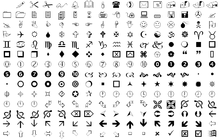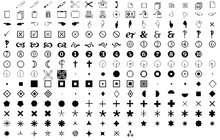Wingdings
Wingdings are a series of dingbat fonts which render letters as a variety of symbols. They were originally developed in 1990 by Microsoft by combining glyphs from Lucida Icons, Arrows, and Stars licensed from Charles Bigelow and Kris Holmes.[1] Certain versions of the font's copyright string include an attribution to Type Solutions, Inc., the maker of a tool used to hint the font.
Wingdings
|
| |
| Category | Symbol |
|---|---|
| Designer(s) |
Charles Bigelow Kris Holmes |
| Foundry | Bigelow and Holmes, Microsoft Corp. |
| Date released | 1990 |
 | |
| Sample | |
Wingdings is a TrueType dingbat font included in all versions of Microsoft Windows from version 3.1 onwards.[2]
The Wingdings trademark is owned by Microsoft,[2] and the design and glyph order was awarded US Design Patent D341848 in 1993.[3][4] The patent expired in 2005. In many other countries, a Design Patent would be called a registered design. It is registration of a design to deter imitation, rather than a claim of a novel invention.
This font contains many largely recognized shapes and gestures as well as some recognized world symbols, such as the Star of David and the symbols of the zodiac. The font is not mapped to Unicode, although many of its symbols are available in that system.[5]

Wingdings 2
|
| |
| Category | Dingbat |
|---|---|
| Designer(s) |
Charles Bigelow Kris Holmes |
| Foundry | Type Solutions |
 | |
| Sample | |
Wingdings 2 is a TrueType font distributed, for example, with Microsoft Office.[6] The font was developed in 1990 by Type Solutions, Inc. The current copyright holder is Microsoft Corp. Among the features of Wingdings 2 are 16 forms of the index, Enclosed Alphanumerics from 0 to 10, multiple forms of ampersand and interrobang, several geometric shapes and an asterism. The font is not mapped to Unicode.

Wingdings 3
|
| |
| Category | Symbol |
|---|---|
| Designer(s) |
Charles Bigelow Kris Holmes |
| Foundry | Type Solutions |
 | |
| Sample | |
Wingdings 3 is a TrueType dingbat font distributed with Microsoft Office and some other Microsoft products.[7]
The font was originally developed in 1990 by Type Solutions, Inc. Currently, the copyright holder is Microsoft Corporation. Wingdings 3 consists entirely of arrow variations.

Controversy

In 1992, only days after the release of Windows 3.1, it was discovered that the character sequence "NYC" in Wingdings was rendered as a skull and crossbones symbol, Star of David, and thumbs up gesture. This was often interpreted as an antisemitic message.[8] Microsoft strongly denied this was intentional, and insisted that the final arrangement of the glyphs in the font was largely random. (The character sequence "NYC" in the later-released Webdings font, in turn, was intentionally rendered as eye, heart, and city skyline, referring to the I Love New York logo.)[9]
9/11 attacks

After September 11, 2001, an email was circulated claiming that entering 'Q33 NY', which it claims is the flight number of the first plane to hit the Twin Towers, in Wingdings would bring up a character sequence of a plane flying into two towers, followed by the skull and crossbones symbol and the Star of David.[10] This is a hoax: the flight numbers of the two airplanes that hit the towers were American Airlines Flight 11 and United Airlines Flight 175; the tail numbers were N334AA and N612UA.
See also
References
- ↑ Notes on Lucida designs(by Charles Bigelow, November 2005)
- ↑ 2.0 2.1 Fonts supplied with Windows 3.1
- ↑ Typeface - Google Patent Search
- ↑ United States Patent: D341848
- ↑ Wingdings character set and equivalent Unicode characters
- ↑ Wingdings 2 - Version 1.55
- ↑ Wingdings 3 - Version 1.55
- ↑ Does Microsoft's Wingdings font includes hidden anti-Semitic and 9/11-referential messages?
- ↑ MS Denies Wingding Thing, Again|Wired Magazine
- ↑ snopes.com: Wingdings
External links
- Wingdings font family information: Wingdings, (Microsoft typography)
- Mikkelson, Barbara & David P. "Wingdings: Does the Wingdings font contain hidden anti-Semitic codes?" at Snopes.com: Urban Legends Reference Pages.
- Wingdings character set and equivalent Unicode characters (Alan Wood's Unicode Resources)
- Glasner, Joanna. "MS Denies Wingding Thing, Again", Wired News. September 22, 2001. Retrieved February 9, 2006.
- Mikkelson, Barbara and David P. Snopes Urban Legends: "September 11: Wingdings", Snopes.com. December 11, 2005. Retrieved February 9, 2006.
- Christensen, Brett M. Q33 NY Wingdings Hoax - Elevens and the Wrath of the Eagle, Hoax Slayer. December 2005. Retrieved May 8, 2011.
| ||||||||||||||||||||||||||||||||||